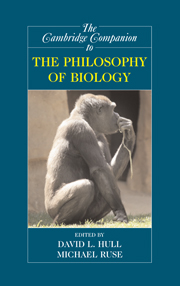Book contents
- Frontmatter
- 1 Adaptation
- 2 Population Genetics
- 3 Units and Levels of Selection
- 4 What’s Wrong with the Emergentist Statistical Interpretation of Natural Selection and Random Drift?
- 5 Gene
- 6 Information in Biology
- 7 Reductionism (and Antireductionism) in Biology
- 8 Mechanisms and Models
- 9 Teleology
- 10 Macroevolution, Minimalism, and the Radiation of the Animals
- 11 Philosophy and Phylogenetics: Historical and Current Connections
- 12 Human Evolution: The Three Grand Challenges of Human Biology
- 13 Varieties of Evolutionary Psychology
- 14 Neurobiology
- 15 Biological Explanations of Human Sexuality: The Genetic Basis of Sexual Orientation
- 16 Game Theory in Evolutionary Biology
- 17 What Is an ‘Embryo’ and How Do We Know?
- 18 Evolutionary Developmental Biology
- 19 Molecular and Systems Biology and Bioethics
- 20 Ecology
- 21 From Ecological Diversity to Biodiversity
- 22 Biology and Religion
- 23 The Moral Grammar of Narratives in History of Biology: The Case of Haeckel and Nazi Biology
- Reference List
- Index
- Series List
10 - Macroevolution, Minimalism, and the Radiation of the Animals
Published online by Cambridge University Press: 28 April 2008
- Frontmatter
- 1 Adaptation
- 2 Population Genetics
- 3 Units and Levels of Selection
- 4 What’s Wrong with the Emergentist Statistical Interpretation of Natural Selection and Random Drift?
- 5 Gene
- 6 Information in Biology
- 7 Reductionism (and Antireductionism) in Biology
- 8 Mechanisms and Models
- 9 Teleology
- 10 Macroevolution, Minimalism, and the Radiation of the Animals
- 11 Philosophy and Phylogenetics: Historical and Current Connections
- 12 Human Evolution: The Three Grand Challenges of Human Biology
- 13 Varieties of Evolutionary Psychology
- 14 Neurobiology
- 15 Biological Explanations of Human Sexuality: The Genetic Basis of Sexual Orientation
- 16 Game Theory in Evolutionary Biology
- 17 What Is an ‘Embryo’ and How Do We Know?
- 18 Evolutionary Developmental Biology
- 19 Molecular and Systems Biology and Bioethics
- 20 Ecology
- 21 From Ecological Diversity to Biodiversity
- 22 Biology and Religion
- 23 The Moral Grammar of Narratives in History of Biology: The Case of Haeckel and Nazi Biology
- Reference List
- Index
- Series List
Summary
MINIMALIST MODELS OF MACROEVOLUTION
Palaeobiology is our main source of direct evidence about the history of life. But while that history is fascinating in itself, palaeobiology's most distinctive contribution to evolutionary theory is the insight it provides on the importance of scale. Palaeobiologists see the results of evolutionary processes summed over huge sweeps of space and time. As a consequence of that window on the effects of deep time and vast space, we have a chance to see whether the palaeobiological record enables us to identify evolutionary mechanisms that are invisible to contemporary microevolutionary studies with their local spatial, temporal, and taxonomic scales. Palaeobiology, in other words, is the discipline of choice for probing the relationship macroevolutionary patterns and microevolutionary processes.
This chapter will be organised around an important framing idea: that of a “minimalist model” of this relationship. I shall discuss minimalism in detail shortly, but as a rough first approximation, according to minimalism, macroevolutionary patterns are direct reflections of microevolutionary change in local populations; they are reflections of changes of the kind we can observe, measure, and manipulate. For example, Michael Benton (forthcoming) discusses models of global species richness that depend on scaling up in space and time equilibrium models of local ecological communities.
- Type
- Chapter
- Information
- The Cambridge Companion to the Philosophy of Biology , pp. 182 - 210Publisher: Cambridge University PressPrint publication year: 2007
- 2
- Cited by



